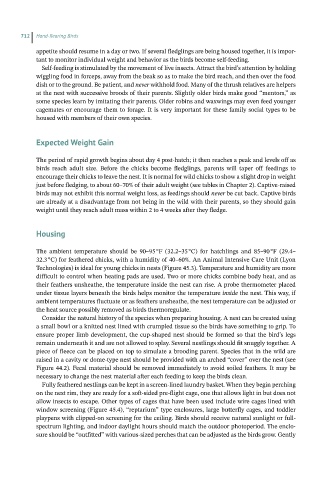Page 710 - Hand rearing birds second
P. 710
712 Hand-Rearing Birds
appetite should resume in a day or two. If several fledglings are being housed together, it is impor-
tant to monitor individual weight and behavior as the birds become self‐feeding.
Self‐feeding is stimulated by the movement of live insects. Attract the bird’s attention by holding
wiggling food in forceps, away from the beak so as to make the bird reach, and then over the food
dish or to the ground. Be patient, and never withhold food. Many of the thrush relatives are helpers
at the nest with successive broods of their parents. Slightly older birds make good “mentors,” as
some species learn by imitating their parents. Older robins and waxwings may even feed younger
cagemates or encourage them to forage. It is very important for these family social types to be
housed with members of their own species.
Expected Weight Gain
The period of rapid growth begins about day 4 post‐hatch; it then reaches a peak and levels off as
birds reach adult size. Before the chicks become fledglings, parents will taper off feedings to
encourage their chicks to leave the nest. It is normal for wild chicks to show a slight drop in weight
just before fledging, to about 60–70% of their adult weight (see tables in Chapter 2). Captive‐raised
birds may not exhibit this normal weight loss, as feedings should never be cut back. Captive birds
are already at a disadvantage from not being in the wild with their parents, so they should gain
weight until they reach adult mass within 2 to 4 weeks after they fledge.
Housing
The ambient temperature should be 90–95 °F (32.2–35 °C) for hatchlings and 85–90 °F (29.4–
32.3 °C) for feathered chicks, with a humidity of 40–60%. An Animal Intensive Care Unit (Lyon
Technologies) is ideal for young chicks in nests (Figure 45.3). Temperature and humidity are more
difficult to control when heating pads are used. Two or more chicks combine body heat, and as
their feathers unsheathe, the temperature inside the nest can rise. A probe thermometer placed
under tissue layers beneath the birds helps monitor the temperature inside the nest. This way, if
ambient temperatures fluctuate or as feathers unsheathe, the nest temperature can be adjusted or
the heat source possibly removed as birds thermoregulate.
Consider the natural history of the species when preparing housing. A nest can be created using
a small bowl or a knitted nest lined with crumpled tissue so the birds have something to grip. To
ensure proper limb development, the cup‐shaped nest should be formed so that the bird’s legs
remain underneath it and are not allowed to splay. Several nestlings should fit snuggly together. A
piece of fleece can be placed on top to simulate a brooding parent. Species that in the wild are
raised in a cavity or dome‐type nest should be provided with an arched “cover” over the nest (see
Figure 44.2). Fecal material should be removed immediately to avoid soiled feathers. It may be
necessary to change the nest material after each feeding to keep the birds clean.
Fully feathered nestlings can be kept in a screen‐lined laundry basket. When they begin perching
on the nest rim, they are ready for a soft‐sided pre‐flight cage, one that allows light in but does not
allow insects to escape. Other types of cages that have been used include wire cages lined with
window screening (Figure 45.4), “reptarium” type enclosures, large butterfly cages, and toddler
playpens with clipped‐on screening for the ceiling. Birds should receive natural sunlight or full‐
spectrum lighting, and indoor daylight hours should match the outdoor photoperiod. The enclo-
sure should be “outfitted” with various‐sized perches that can be adjusted as the birds grow. Gently

